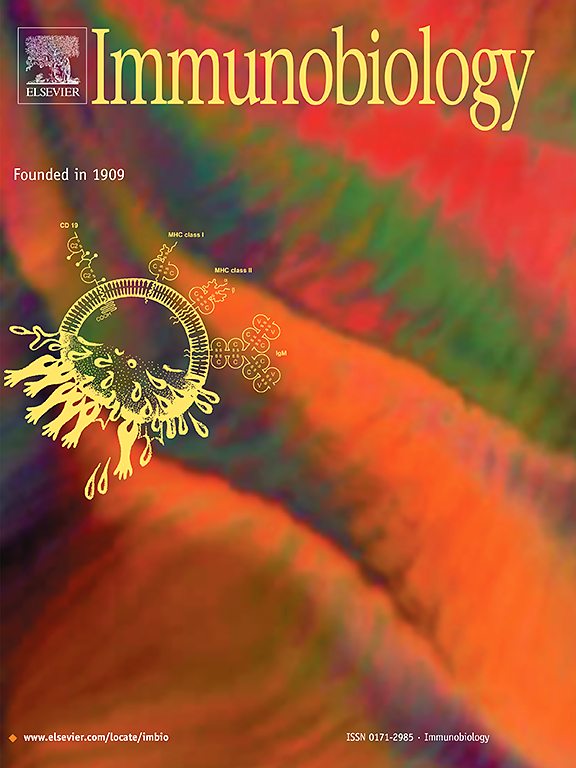Quantification and clustering of immune states in hepatitis B Cirrhosis
IF 2.3
4区 医学
Q3 IMMUNOLOGY
引用次数: 0
Abstract
Background
Hepatitis B Cirrhosis, a severe progression of chronic Hepatitis B infection, requires a comprehensive understanding of the interplay among lymphocyte populations. This study aims to quantify and visualize the relationships among T cells, NK cells, and B cells to aid in assessing immune status, diagnosing the condition, and optimizing treatment strategies.
Methods
Peripheral blood samples were collected from 500 patients diagnosed with Hepatitis B Cirrhosis and 500 healthy controls. Sort visualization analysis and three-dimensional numerical fitting were performed to establish a mathematical model describing the relationships among lymphocyte subsets. Self-Organizing Feature Maps (SOFM) were employed for unsupervised clustering to identify distinct immune states.
Results
Sort visualization analysis revealed a gradual decrease in T + NK cell levels as B cell levels increased, demonstrating a clear inverse relationship. SOFM clustering identified three distinct clusters with well-defined boundaries. In the 3D lymphocyte plane described by the eq. T percentage = ‐−0.9879 × B percentage - 1.041 × NK percentage + 97.66, a significant contrast was observed between Hepatitis B Cirrhosis samples and the healthy sample baseline. Analysis across Child-Pugh grades uncovered a cyclical pattern in immune states, reflecting the various stages of the viral infection process.
Conclusions
This study provides a quantitative mathematical model and visual representation of lymphocyte population dynamics in Hepatitis B Cirrhosis. The identification of distinct immune states associated with disease progression facilitates the assessment of immunological condition and the optimization of treatment strategies. The integration of immunological and clinical data opens new possibilities for more precise disease staging and personalized.

乙型肝炎肝硬化患者免疫状态的量化和聚类
肝硬化是慢性乙型肝炎感染的一种严重进展,需要对淋巴细胞群之间的相互作用有全面的了解。本研究旨在量化和可视化T细胞、NK细胞和B细胞之间的关系,以帮助评估免疫状态、诊断病情和优化治疗策略。方法采集500例乙型肝炎肝硬化患者和500例健康对照者的外周血标本。通过排序可视化分析和三维数值拟合,建立描述淋巴细胞亚群之间关系的数学模型。采用自组织特征映射(SOFM)进行无监督聚类,识别不同的免疫状态。结果排序可视化分析显示,T + NK细胞水平随着B细胞水平的升高而逐渐降低,呈明显的反比关系。SOFM聚类识别出三个具有明确边界的不同聚类。在由等式T百分比=‐−0.9879 × B百分比- 1.041 × NK百分比+ 97.66描述的三维淋巴细胞平面上,乙型肝炎肝硬化样本与健康样本基线之间存在显著对比。对Child-Pugh年级的分析揭示了免疫状态的周期性模式,反映了病毒感染过程的各个阶段。结论本研究提供了乙肝肝硬化患者淋巴细胞群动态的定量数学模型和直观表征。识别与疾病进展相关的不同免疫状态有助于评估免疫状况和优化治疗策略。免疫学和临床数据的整合为更精确的疾病分期和个性化提供了新的可能性。
本文章由计算机程序翻译,如有差异,请以英文原文为准。
求助全文
约1分钟内获得全文
求助全文
来源期刊

Immunobiology
医学-免疫学
CiteScore
5.00
自引率
3.60%
发文量
108
审稿时长
55 days
期刊介绍:
Immunobiology is a peer-reviewed journal that publishes highly innovative research approaches for a wide range of immunological subjects, including
• Innate Immunity,
• Adaptive Immunity,
• Complement Biology,
• Macrophage and Dendritic Cell Biology,
• Parasite Immunology,
• Tumour Immunology,
• Clinical Immunology,
• Immunogenetics,
• Immunotherapy and
• Immunopathology of infectious, allergic and autoimmune disease.
 求助内容:
求助内容: 应助结果提醒方式:
应助结果提醒方式:


